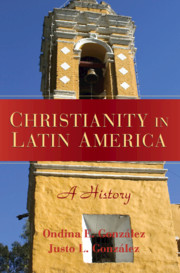Book contents
- Frontmatter
- Contents
- Preface
- Introduction
- 1 Foundations
- 2 The Arrival of Christianity
- 3 The Shaping of the Faith
- 4 Reform Movements
- 5 The Church in Turmoil
- 6 The Church's New Place
- 7 Protestant Immigration
- 8 An Expanding Protestant Presence
- 9 Catholicism after Vatican II
- 10 Pentecostalism and Autochthonous Movements
- 11 By Way of Conclusion
- Some Suggestions for Further Reading
- Sources Referenced
- Index
Introduction
Published online by Cambridge University Press: 05 June 2012
- Frontmatter
- Contents
- Preface
- Introduction
- 1 Foundations
- 2 The Arrival of Christianity
- 3 The Shaping of the Faith
- 4 Reform Movements
- 5 The Church in Turmoil
- 6 The Church's New Place
- 7 Protestant Immigration
- 8 An Expanding Protestant Presence
- 9 Catholicism after Vatican II
- 10 Pentecostalism and Autochthonous Movements
- 11 By Way of Conclusion
- Some Suggestions for Further Reading
- Sources Referenced
- Index
Summary
THE NEW WORLD AND THE OLD
It is said that Charles V, annoyed when someone blocked his carriage, asked who dared stand in the way of the Holy Roman Emperor, the King of Castile, Leon, Aragon, and the Two Sicilies – and a dozen other titles of lesser importance. The man impeding the king's progress – Hernán Cortés by name – responded, “One who gave thee more lands than did thy father!”
The story may not be absolutely true, but the point it makes certainly is. The “discovery” and conquest of the “New World” forever changed the “Old.” As a result, the Irish would eventually become known for their potatoes, the Italian for their polenta and tomato sauces, and the Swiss for their chocolate. Such dietary changes are but a sign of the profound impact of the Americas on Europe. Even traditional religion and theology were challenged, forcing theologians to rethink much that they had considered settled. According to ancient traditions, before leaving Jerusalem the apostles divided the world among themselves, so that the Gospel would be preached “to every creature.” But now there were millions of people in lands where apparently no apostle had set foot. Were they excluded from the grace of God? Were they actually human? Did they have souls? Were they rightful owners of their land? As we will see in Chapter 2, these debates – with far-reaching economic and political consequences – soon raged in Europe.
- Type
- Chapter
- Information
- Christianity in Latin AmericaA History, pp. 1 - 11Publisher: Cambridge University PressPrint publication year: 2007



